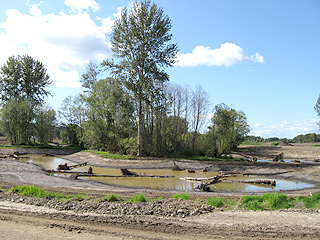
Surveys
DJC.COM
July 30, 2009
Fish find refuge on the lower Puyallup River
Ridolfi Inc.

Wagoner
|
A single juvenile coho salmon, netted and released last March, is the bellwether fish that shows how a clear vision and sustained effort can restore river habitat to support salmon runs.
This story began nearly 100 years ago, when Pierce County undertook a massive construction effort to straighten the wild Puyallup River, erecting levees on both banks to contain floodwaters. While this might have been a worthwhile endeavor in terms of infrastructure, there were consequences for salmon and their habitat: The river behaved more like a flume — an open, artificial water channel — than a natural system.
Juvenile salmon need places to seek refuge from predators and escape high water velocities, as well as opportunities to feed, as they make their way downstream to the ocean. Straightening and diking the river destroyed off-channel habitat and disconnected the river from the floodplain, which eliminated these critical feeding and refuge pockets.

Photo by Steve Hannan/Ridolfi Inc.
Sha Dadx has off-channel pools with large logs for fish refuge. |
More than a decade ago, the Puyallup Tribe, which has historically depended on salmon for food and is a co-manager of the fisheries resource in the Puyallup River, began identifying potential sites for habitat restoration.
The site known as Sha Dadx bubbled to the top of the list for several reasons:
• It includes a bend of the historical river channel that was abandoned when the river was straightened.
• It is just below the upstream edge of tidal influence, which is where juvenile salmon begin to adjust to salt water.
• The tribe already managed the site as a consequence of a land settlement with local governments, which streamlined the restoration process.
• Superfund settlements for natural resource damages to Commencement Bay made restoration funds available.
The Commencement Bay natural resource trustees, led by the National Oceanic and Atmospheric Administration, engaged Ridolfi Inc. to manage the Sha Dadx restoration project.
An eclectic design team of specialists was put together to execute on the vision: landscape architecture was handled by Osborn Pacific Group; wetland studies were performed by ESA/Adolfson; cultural resources were assessed by Historical Research Associates; geotechnical work was conducted by GeoEngineers; structural engineering was the responsibility of Bright Engineering; and Ridolfi took on project management, civil engineering, fisheries and permitting.
Since the design called for punching a hole through the levee to install a culvert, the work also had to be tightly coordinated with engineers at Pierce County Water Programs, which is responsible for maintaining levees on the Puyallup River upstream of the Interstate 5 bridge.
To alleviate their concerns, the design used redundant protections: a ring levee around the project area tied into the existing levee and a floodgate that will shut if the water level in the river exceeds 18 feet. The structural engineers designed a 10-foot-diameter, thick-walled culvert that was hydraulically driven under the existing levee without disrupting traffic on an important arterial.
Having dealt with the engineering challenges, the team turned to the core of the project: habitat design.
To benefit salmon, the restoration had to provide off-channel aquatic habitat that mimicked the complexity found in natural systems. The layout therefore included channels and pools designed to be permanently wet — so that fish could use the site at any time of the year and at any tidal stage — and enhanced with large woody debris to create a diverse habitat with places for fish to find shade and refuge from predators.
Features were laid out to protect as many of the existing large cottonwood and alder trees as possible, as well as to save an isolated pool that already provided habitat for waterfowl. Finally, appropriate native plants were selected for different parts of the site based on hydrology and shading characteristics.
In all, the Sha Dadx site includes 18 acres of wetland and riparian habitat.
Wade Perrow Construction built the project in the summer and fall of 2008. First, the perimeter of the ring levee was cleared and nearly 1,000 well points were installed to dewater the site so that construction could take place “in the dry.” Next, trees were gingerly removed and stockpiled for subsequent use as large woody debris or chipped for mulch. The ring levee was constructed in thin lifts of select fill, which was created by mixing soil salvaged from excavated areas with imported materials.
By early November, the heavy construction was complete and a small earthen berm was breached, allowing water to flow from the river into the reconstructed habitat area for the first time in nearly a century.
The Associated General Contractors recognized the constructor and designers with a 2009 Build Washington award for excellence in the environmental category, and the Puyallup Tribal News called Sha Dadx “the crown jewel of the tribe’s restoration projects.”
But the most important reward came in March, when biologists from the Puyallup Tribe visited Sha Dadx to monitor fish use of the site. They spread their nets across the channel and caught that lone juvenile salmon, which was soon released to continue its journey to the sea. Here was visible proof that engineers, scientists and contractors from the private, public and tribal sectors can successfully collaborate to restore river habitat so that it can better support our region’s iconic wild salmon runs.
Colin Wagoner, PE, LHG, is principal engineer and CEO of Ridolfi Inc., where he has managed the firm’s habitat restoration projects and other environmental studies for the last 10 years.
Other Stories:
- How people influence long-term sustainable success
- For a greener future, look to the past
- Going green with government tax incentives
- Puget Sound’s invisible enemy: polluted stormwater
- Are you sure you’re ready to go green?
- Is vapor intrusion the next regulatory juggernaut?
- Improving water quality in Holmes Harbor
- A watershed approach to mitigation and restoration
- Why buildings can never be regenerative
Copyright ©2009 Seattle Daily Journal and DJC.COM.
Comments? Questions? Contact us.